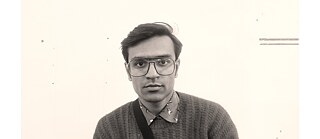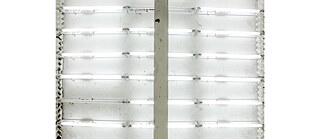About the Actant
 © Divyesh Amrish Undaviya
Divyesh Undaviya is a visual artist whose practice is installation based and traverses several mediums, approaches and strategies. Spaces as well as the idea of space and personal experiences associated with them have been the centre of his process and practice. Engagement of people with these spaces is of particular interest which creates a complex web of experiences and visuals where their power to imagine and construct narratives takes the front seat while his becomes an underlying shadow. Being perpetually surrounded by spaces, each with their own specific designation, functionality, design, physicality and purpose makes him want to comprehend these elements. Intervention and manipulation of the physical space breaks certain notions associated with them. Normalizing happens on a daily basis which is the result of an unconscious effort. Experience of the everyday in one’s mind and memory, assumes the form of a pattern in a way that is repetitive, and predictable - there are often motifs that reappear and fit in pre-designated spaces. A small change in the visual has the potential to alter the larger scheme of things – a visual disturbance as such can be extended to represent another anomaly and metaphorically suggest how changes alter perception. Alterations to objects and spaces have a certain shock value that catches the viewer’s attention and makes one question the whole and not just a part. Divyeshs' works often expose the power play between the close symbiotic relationship that humans and spaces share. The dynamic between space and humans often witnesses the human trying to establish their dominance by doing the seemingly impossible.
© Divyesh Amrish Undaviya
Divyesh Undaviya is a visual artist whose practice is installation based and traverses several mediums, approaches and strategies. Spaces as well as the idea of space and personal experiences associated with them have been the centre of his process and practice. Engagement of people with these spaces is of particular interest which creates a complex web of experiences and visuals where their power to imagine and construct narratives takes the front seat while his becomes an underlying shadow. Being perpetually surrounded by spaces, each with their own specific designation, functionality, design, physicality and purpose makes him want to comprehend these elements. Intervention and manipulation of the physical space breaks certain notions associated with them. Normalizing happens on a daily basis which is the result of an unconscious effort. Experience of the everyday in one’s mind and memory, assumes the form of a pattern in a way that is repetitive, and predictable - there are often motifs that reappear and fit in pre-designated spaces. A small change in the visual has the potential to alter the larger scheme of things – a visual disturbance as such can be extended to represent another anomaly and metaphorically suggest how changes alter perception. Alterations to objects and spaces have a certain shock value that catches the viewer’s attention and makes one question the whole and not just a part. Divyeshs' works often expose the power play between the close symbiotic relationship that humans and spaces share. The dynamic between space and humans often witnesses the human trying to establish their dominance by doing the seemingly impossible.
 © Divyesh Amrish Undaviya
In What Just Happened? Why Am I Here? I Want to go Home, Divyesh created an immersive environment that is suspended in time – a site of incidents without a time stamp – wherein the viewer’s preconceived notions of what a space should look like, or what its history is, are immediately challenged when they are confronted by the surreal. The work on the surface will remind one of a set created for say a movie or an image of the aftermath – it may seem under construction or abandoned – but the incident will not be verified; it will not be narrated. Divyesh was interested in the incident being a speculation or a rumour or an urban legend – a possibility of stories and imagination. The site was the point of departure from which all those who experienced it, thought through the question, “What may have happened?”
© Divyesh Amrish Undaviya
In What Just Happened? Why Am I Here? I Want to go Home, Divyesh created an immersive environment that is suspended in time – a site of incidents without a time stamp – wherein the viewer’s preconceived notions of what a space should look like, or what its history is, are immediately challenged when they are confronted by the surreal. The work on the surface will remind one of a set created for say a movie or an image of the aftermath – it may seem under construction or abandoned – but the incident will not be verified; it will not be narrated. Divyesh was interested in the incident being a speculation or a rumour or an urban legend – a possibility of stories and imagination. The site was the point of departure from which all those who experienced it, thought through the question, “What may have happened?”
The progression from one room to another takes you deeper and deeper into a surreal construction, each one complete in its own way but forming a part of the speculation – the figment of each person’s mind. There also exists various degrees of alterations within each space, some only slightly offset from reality and others drastically dreamlike. The materials employed for the work traverse a range of classes in an attempt to hint at spatial issues being tackled by the section of society.

